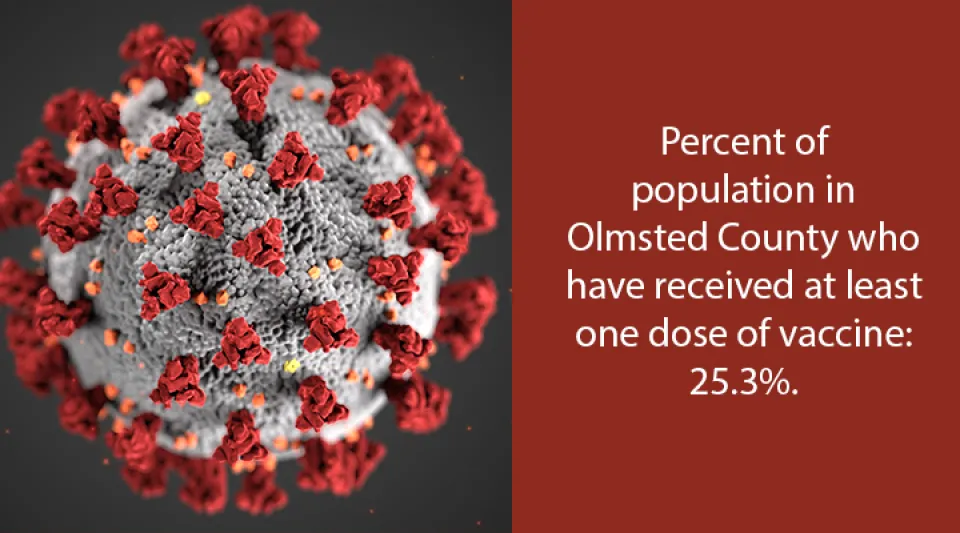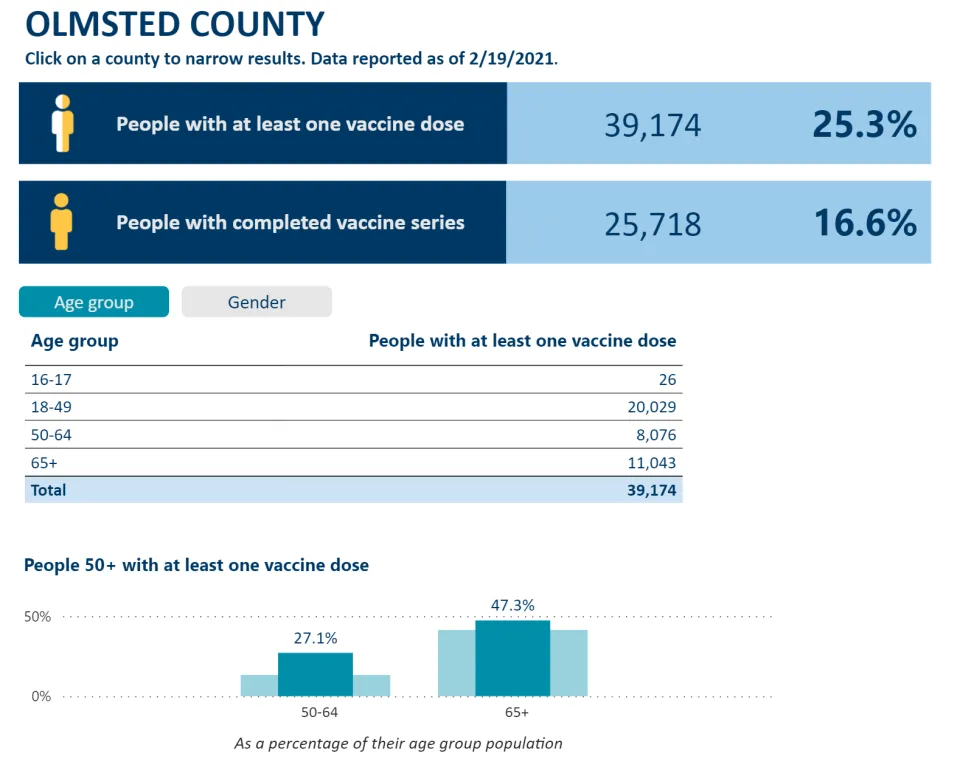COVID-19 vaccine newsletter - February 23, 2021
What's new?
Take the first opportunity to get vaccinated that is offered to you
Navigating when you or a loved one is eligible to receive the COVID-19 vaccine can be challenging. Several locations in Olmsted County are offering the vaccine in alignment with state guidelines as vaccine supply becomes available. Minnesota is currently vaccinating remaining health care professionals, persons 65 and over, E-12 educators and support staff, and daycare workers. You may have the opportunity to receive the COVID-19 vaccine at multiple locations. It’s okay to be a part of several options. Take the first opportunity to get vaccinated that is offered to you. Visit our COVID webpage regularly for the most up to date information.
State of Minnesota Vaccine Connector
The Minnesota COVID-19 Vaccine Connector is a new tool launched by the State of Minnesota to help Minnesotans find out when, where, and how to get their COVID-19 vaccine. When you become eligible to receive the vaccine, the Vaccine Connector will:
- Alert you of your eligibility.
- Connect you to resources to schedule a vaccine appointment.
- Notify you if there are vaccine opportunities in your area.
The Vaccine Connector is intended to be an easy way to stay updated about your eligibility and find opportunities to get a shot when it’s your turn.
Minnesotans age 65+ who sign up with the Vaccine Connector will be automatically included in the selection process for appointments at state-run community vaccination sites. Learn more about the Minnesota COVID-19 Vaccine Connector.

Vaccine status updates
Vaccine shipment delays
Last week, several states, including Minnesota, experienced delays in COVID-19 vaccine shipments due to severe weather conditions in various parts of the United States. As a result, several state-run and local COVID-19 vaccination clinics and some individual vaccination appointments were postponed. Impacted individuals have been contacted and appointments are being re-rescheduled.
Olmsted County Public Health Services (OCPHS)
COVID-19 vaccine - 2nd dose re-registration
OCPHS sent an email on Friday, February 19, 2021 to individuals who received their first dose of the COVID vaccine on February 5 and 6 at the RCTC fieldhouse or on February 9 at Olmsted County Public Health. These individuals were advised they needed to re-register for their second dose. Only those who received their first COVID vaccine on the dates and locations listed above are affected by this request. If you received a first dose on one of the dates above but were not contacted, please contact the COVID-19 Community Call Center at 507-328-2822.
Progress on vaccinations across the county
Progress is being made as a community with 25.3% of the total population having received at least one dose of vaccine and 16.6% completing the two-dose series. We are also seeing great progress with adults 65 and older with 47.3% of county residents in that population having received at least one dose through their medical provider or one of the state-run clinics.

Mayo Clinic
Mayo Clinic continues to receive a small weekly shipment of COVID-19 vaccines for Minnesota residents 65 and older. Given the need to equitably distribute doses and the high number of patients in this age group, we are currently vaccinating those 75 and older. COVID-19 vaccination eligibility will continue to expand to younger age groups as we receive supplies of COVID-19 vaccines.
For patients to be vaccinated for COVID-19 by Mayo Clinic in Minnesota, they must:
- Have a primary care provider at Mayo, have been seen within the past two years and have a residence in Minnesota (may include some Iowa and Wisconsin patients); or,
- Have been seen at Mayo Clinic within the past two years and have a residence within the catchment area where they were seen. These criteria will be used for patients who do not have a primary care provider at Mayo ― that is, they have been to Mayo for specialty care only.
The catchment area includes Blue Earth, Brown, Dodge, Faribault, Fillmore, Freeborn, Goodhue, Houston, Le Sueur, Martin, Mower, Nicollet, Olmsted, Rice, Scott, Steele, Wabasha, Waseca, Watonwan, and Winona counties.
Patients who meet these criteria will receive a phone call or an invitation via Patient Online Services to schedule an appointment to be vaccinated for COVID-19. Patients who do not have a Patient Online Services account can visit onlineservices.mayoclinic.org or call Mayo Clinic Customer Assistance at 877-858-0398 to establish one.
Olmsted Medical Center (OMC)
OMC is currently offering vaccinations to patients 75+ (as well as others in the same household age 65+), through a randomized process, as vaccine becomes available. When OMC finishes with this group, it will offer vaccine to patients to the next age group as vaccine is available and depending on the amount of vaccine it receives. OMC does not have a timeframe for when the next age group will start or what ages will be included. Patients who are eligible for the vaccine will be contacted by OMC; there is no sign-up list.
Education / information
What is herd immunity?
The following information comes from the Minnesota Department of Health, the Centers for Disease Control and Prevention, and Mayo Clinic.
Herd immunity occurs when a large portion of a community (the herd) becomes immune to a disease, making the spread of disease from person to person unlikely. As a result, the whole community becomes protected — not just those who are immune.
Often, a percentage of the population must be capable of getting a disease in order for it to spread. This is called a threshold proportion. If the proportion of the population that is immune to the disease is greater than this threshold, the spread of the disease will decline. This is known as the herd immunity threshold.
What percentage of a community needs to be immune in order to achieve herd immunity? It varies from disease to disease. The more contagious a disease is, the greater the proportion of the population that needs to be immune to the disease to stop its spread. For example, the measles is a highly contagious illness. It's estimated that 94% of the population must be immune to interrupt the chain of transmission.
How is herd immunity achieved?
There are two paths to herd immunity for COVID-19 — vaccines and infection.
Vaccines
Vaccines create immunity without causing illness or resulting complications. Herd immunity makes it possible to protect the population from a disease, including those who can't be vaccinated, such as newborns or those who have compromised immune systems. Using the concept of herd immunity, vaccines have successfully controlled deadly contagious diseases such as smallpox, polio, diphtheria, rubella, and many others.
Reaching herd immunity through vaccination sometimes has drawbacks though. Protection from some vaccines can wane over time, requiring revaccination. Sometimes people don't get all of the shots they need to be completely protected from a disease.
In addition, some people may object to vaccines because of religious objections, fears about the possible risks, or skepticism about the benefits. People who object to vaccines often live in the same neighborhoods or attend the same religious services or schools.
If the proportion of vaccinated people in a community falls below the herd immunity threshold, exposure to a contagious disease could result in the disease quickly spreading. Measles has recently resurged in several parts of the world with relatively low vaccination rates, including the United States. Opposition to vaccines can pose a real challenge to herd immunity.
Natural infection
Herd immunity can also be reached when a sufficient number of people in the population have recovered from a disease and have developed antibodies against future infection. For example, those who survived the 1918 flu (influenza) pandemic were later immune to infection with the H1N1 flu, a subtype of influenza A. During the 2009-10 flu season, H1N1 caused the respiratory infection in humans that was commonly referred to as swine flu.
However, there are some major problems with relying on community infection to create herd immunity to the virus that causes COVID-19. First, it isn't yet clear if infection with the COVID-19 virus makes a person immune to future infection.
Research suggests that after infection with some coronaviruses, reinfection with the same virus — though usually mild and only happening in a fraction of people — is possible after a period of months or years. Further research is needed to determine the protective effect of antibodies to the virus in those who have been infected.
Even if infection with the COVID-19 virus creates long-lasting immunity, a large number of people would have to become infected to reach the herd immunity threshold. Experts estimate that in the U.S., 70% of the population — more than 200 million people — would have to recover from COVID-19 to halt the epidemic. If many people become sick with COVID-19 at once, the health care system could quickly become overwhelmed. This amount of infection could also lead to serious complications and millions of deaths, especially among older people and those who have chronic conditions.
